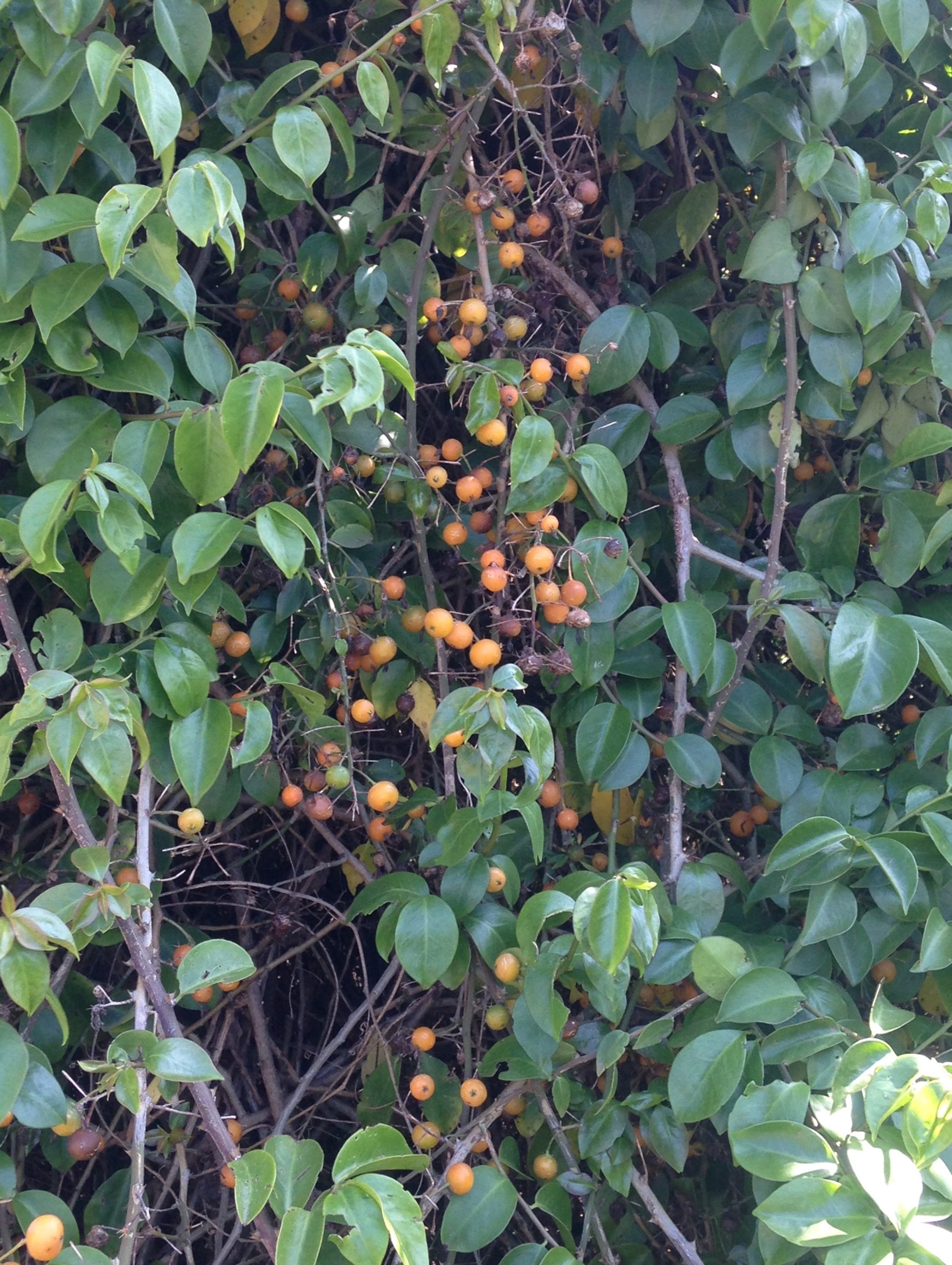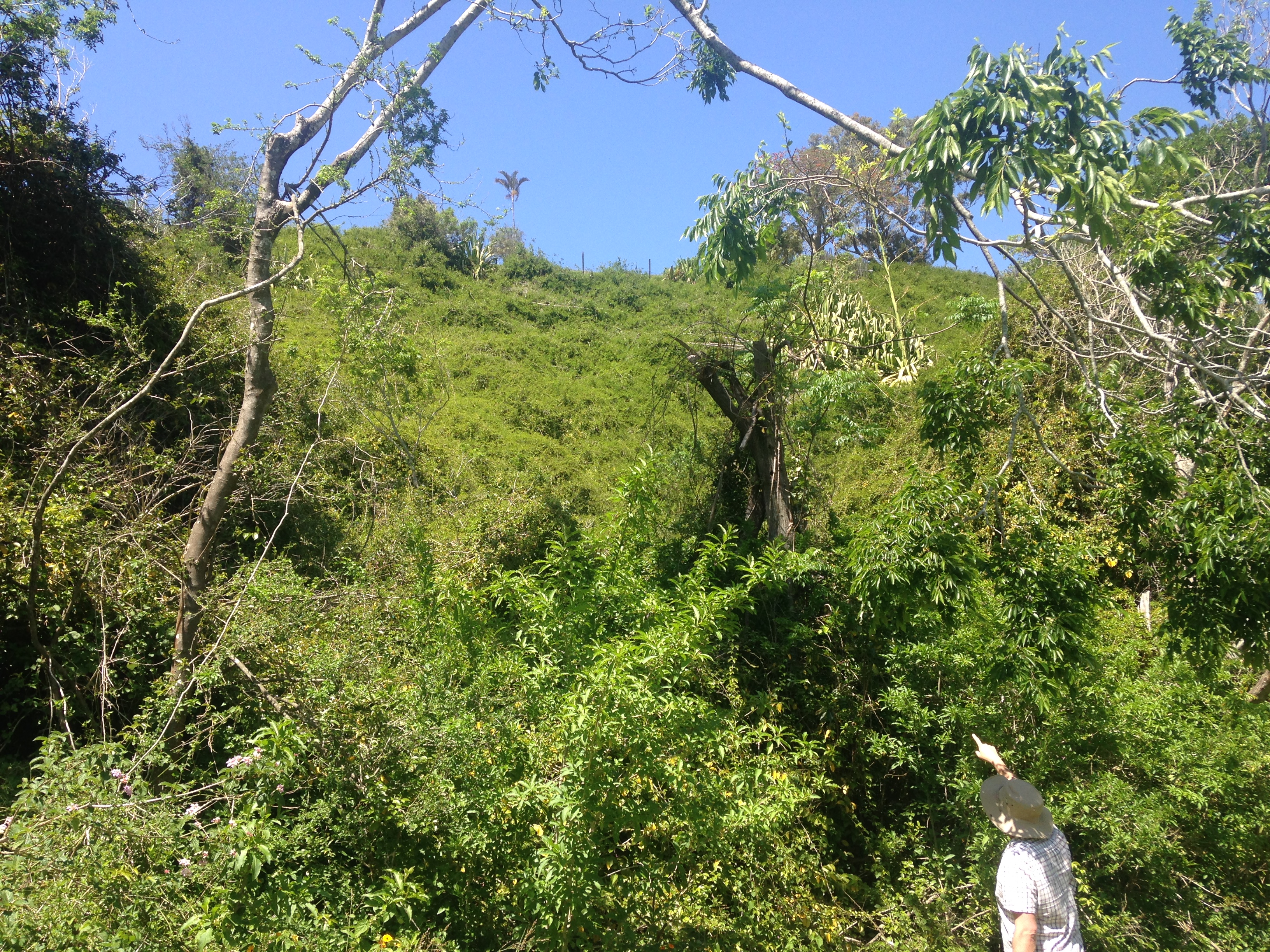Leaf cactus
Leaf cactus (Pereskia aculeata), a primitive climbing cactus, is an environmental weed in New South Wales and Queensland. It invades riparian zones, urban bushland, open woodlands, dry forests (including mature native and planted stands), and shrubby rocky areas. Its brightly coloured fruits are bird dispersed and vegetative fragments are often viable.
This sub-project focuses on the stem-wilting bug Catorhintha schaffneri, which attacks the new growth of leaf cactus and as a result reduces flowering and fruiting. In its native range (Brazil) and in South Africa where it has been released as a biocontrol agent against leaf cactus, the stem-wilting bug has been found to damage a significant number of shoot tips (sometimes as much as 90%). Host-specificity tests performed in South Africa showed that this insect is highly specific. Additional host-specificity testing, comprising non-target species relevant to the Australian context, are being performed in quarantine facilities in South Africa and Australia to complement previous results. It is noteworthy that Australia does not have any native species in the Cactaceae family to which leaf cactus belongs. Approval for its release in Australia will be sought from the relevant authorities, pending results indicate that the stem-wilting bug does not pose a threat to non-target species.
Andrew McConnachie of NSW Department of Primary Industries is leading this sub-project.

Close-up of leaf cactus leaves, fruits and spines (Photo: A. McConnachie, NSW DPI).
Background
Why is the weed a problem?
Due to its climbing nature and the dispersal of seeds in bird droppings, leaf cactus is highly invasive in both disturbed and undisturbed habitats and has significant potential for rapid spread in Australia. As leaf cactus is currently found over a wide range of dry forest habitats, Australia’s natural eucalypt woodlands are at serious risk. A single leaf cactus plant can smother and kill mature trees, even collapsing otherwise substantial forest under the sheer weight of an infestation. This is a problem for both native and plantation forests. Leaf cactus is also armed with paired, hooked thorns at the leaf-bases on the young, green shoots and clusters of long spines which develop progressively on the older, woody stems. These cause physical harm to any animal moving through its growth, as well as rendering access to invaded areas near impossible.

A severe infestation of leaf cactus in South Africa: What NSW natural areas could possibly look like in the future if no effective control solution is developed (Photo: A. McConnachie, NSW DPI).
How is the weed currently managed?
Management of leaf cactus using mechanical and chemical control methods is not effective. Because leaf cactus usually grows intertwined with native vegetation, these control methods often have deleterious consequences for non-target vegetation. Manual removal is extremely difficult as the plant is i) extremely spiny, presenting a significant risk to the person removing it; ii) potentially enormous (the sheer scale associated with an up to 10-metre high entanglement within the supporting trees as well as the root network; and iii) easily grown from fragments. And because herbicides are not translocated effectively throughout the plant’s tissues, all parts of the plant have to be sprayed for effective control.
Current recommendations for management of leaf cactus in Australia are to: i) prevent introduction and spread of the weed at new locations; and ii) report new outbreaks to state or territory weed management agency or local council so that it can be professionally eradicated (this may include a combination of cut stump followed by foliar spray treatments).
Previous research
In South Africa, two biological control agents have been released for the management of the leaf cactus. The flea-beetle, Phenrica guerini (Chrysomelidae), was released in 1991 and is now damaging at about 6 sites and is present, but not damaging at about 25 other sites. The limited success of the flea-beetle in controlling leaf cactus at most sites where it was released in South Africa, prompted the release of a second agent, the stem-wilting bug Catorhintha schaffneri (Coreidae) in October 2014. This insect is currently established at at least six sites in South Africa, ranging from the warmer regions of KwaZulu-Natal to the much cooler Eastern Cape. It is likely that the stem-wilting bug is also present at other sites, but has not reached high enough densities to be observed yet. It is too soon to determine whether the stem-wilting bug will effectively control leaf cactus throughout its invaded range in South Africa. Initial observations, however have been very positive, with about 90% of shoot tips of leaf cactus destroyed at some sites. New South Wales would benefit from the release of both biological control agents, however, as a first step, and with input from South African researchers, the first agent to be considered will be the stem-wilting bug.

Damage to a shoot tip caused by the stem-wilting bug Catorhintha schaffneri in the field in South Africa (left) (Photo: A. McConnachie, NSW DPI). Nymph (top right) and adults (bottom right) of the stem-wilting bug (Photos: Iain Paterson, Rhodes University).
Trust-funded sub-project
The stem-wilting bug C. schaffneri was selected as the most promising candidate agent of leaf cactus to pursue for the sub-project supported by the NSW Environmental Trust because it:
- was shown to be highly host-specific in testing performed in South Africa,
- it is very damaging to new shoots, so preventing flowering and the setting of seed,
- has had good rates of establishment in leaf cactus infestations in South Africa that have similar climatic conditions to those found in Australia,
- it is currently being reared under quarantine conditions in South Africa and once initial testing on Australian species has been concluded there, a clean culture can readily be exported to Australia for further testing.
The key activities of the sub-project are to:
- Prepare and submit to the national Environment and Invasive Committee an information dossier to support the nomination of leaf cactus as a target for biocontrol in Australia.
- Undertake in both South Africa and Australia, additional host-specificity testing of C. schaffneri on closely-related plant species to leaf cactus, including selected Australian native species and, pending results indicate that the insect does not pose a threat to non-target species.
- Prepare and submit to the relevant authorities an application for its release in Australia for the biocontrol of leaf cactus, pending results indicate that the insect does not pose a threat to non-target species.
Progress
October 2021
The Department of Agriculture, Water and the Environment (DAWE) performed an initial review of the submitted application to release the stem-wilting bug for biocontrol of leaf cactus in Australia. Following this review, DAWE requested testing on six additional plant species before the release application can proceed further through the review process. The stem-wilter bug will be imported in the NSW DPI quarantine facility in Orange in the near future to undertake this additional testing. Test results will then be provided to DAWE to complement the already-submitted release application for the stem-wilter bug.
January 2021
The application to release the stem-wilting bug for biocontrol of leaf cactus in Australia was submitted to the Department of Agriculture, Water and the Environment on 20 January 2021. The process for review of such applications is outlined on the Department website at https://www.agriculture.gov.au/biosecurity/risk-analysis/biological-control-agents/protocol_for_biological_control_agents
2019/20
The nomination of leaf cactus as a target for biocontrol, submitted to the Environment and Invasives Committee (EIC) in the previous reporting period (May 2019), was endorsed by the Committee in Oct 2019. All host-specificity testing with the stem-wilting bug has now been completed by the subcontractor at the Centre for Biological Control, Rhodes University, in South Africa under the supervision of NSW DPI. Results support those of earlier work conducted in South Africa, indicating that the candidate agent is suitably host specific for release in Australia. An application to release the stem-wilting bug is being prepared.
July 2018
This sub-project commenced in July 2018.
Acknowledgement
The assistance of Ashara Patterson in Australia is acknowledged. The research has be conducted in South Africa by Dr Iain Paterson (Rhodes University).
Thanks to all collaborators who kindly made collections of leaf cactus accessions in Australia and some of the non-target plant species.


